Pearl Extract Market
Pearl Extract Market Size and Share Forecast Outlook 2025 to 2035
Pearl extract market is projected to grow from USD 470.0 million in 2025 to USD 760.0 million by 2035, at a CAGR of 4.9%. Freshwater will dominate with a 70.0% market share, while cosmetics will lead the application segment with a 60.0% share.
Pearl Extract Market Forecast and Outlook 2025 to 2035
The global pearl extract market is projected to reach USD 760.0 million by 2035, recording an absolute increase of USD 290.0 million over the forecast period. The market is valued at USD 470.0 million in 2025 and is set to rise at a CAGR of 4.9% during the assessment period.
The market is expected to grow by nearly 1.6 times during the same period, supported by increasing demand for premium cosmetic ingredients and growing consumer awareness of marine-derived beauty products, driving demand for advanced extraction technologies and increasing investments in pearl farming and processing facilities globally. However, high raw material costs for quality pearl sources and complex extraction procedures may pose challenges to market expansion.
Quick Stats for Pearl Extract Market
- Pearl Extract Market Value (2025): USD 470.0 million
- Pearl Extract Market Forecast Value (2035): USD 760.0 million
- Pearl Extract Market Forecast CAGR: 4.9%
- Leading Type in Pearl Extract Market: Freshwater
- Key Growth Regions in Pearl Extract Market: Asia Pacific, Europe, and North America
- Top Players in Pearl Extract Market: Mikimoto, KANEBO, Shiseido, Pearl Extract Co Japan, Natura Pearl, The Body Shop, Maruzen Chemical, Nature's Pearl, Dr. Mercola, NOW Foods, Oyster Pearl Co., Hanh & Company, Taiyo, Marine Essence, Hokkaido Bio
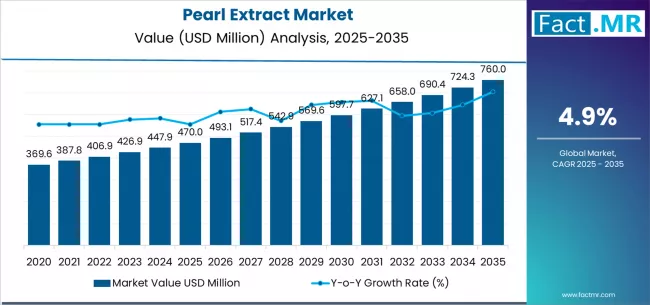
Pearl Extract Market Year-over-Year Forecast (2025-2035)
Between 2025 and 2030, the pearl extract market is projected to expand from USD 470.0 million to USD 597.0 million, resulting in a value increase of USD 127.0 million, which represents 43.8% of the total forecast growth for the decade.
This phase of development will be shaped by rising demand for premium cosmetic ingredients and specialized beauty applications, product innovation in extraction technologies and processing methods, as well as expanding integration with modern skincare formulations and nutraceutical applications.
Companies are establishing competitive positions through investment in extraction capabilities, high-performance processing technologies, and strategic market expansion across cosmetics, nutraceuticals, and pharmaceutical applications.
From 2030 to 2035, the market is forecast to grow from USD 597.0 million to USD 760.0 million, adding another USD 163.0 million, which constitutes 56.2% of the overall ten-year expansion.
This period is expected to be characterized by the expansion of specialized extraction formulations, including advanced processing systems and integrated beauty solutions tailored for specific cosmetic requirements, strategic collaborations between manufacturers and beauty companies, and an enhanced focus on regulatory harmonization and standardized extraction practices.
The growing emphasis on natural beauty ingredients and comprehensive wellness solutions will drive demand for comprehensive pearl extract systems across diverse cosmetic applications.
Pearl Extract Market Key Takeaways
| Metric | Value |
|---|---|
| Market Value (2025) | USD 470.0 million |
| Market Forecast Value (2035) | USD 760.0 million |
| Forecast CAGR (2025-2035) | 4.9% |
Why is the Pearl Extract Market Growing?
The pearl extract market grows by enabling cosmetic companies and beauty manufacturers to optimize product formulations while accessing premium marine ingredients without substantial infrastructure requirements.
Beauty firms and cosmetic brands face mounting pressure to improve product efficacy and meet consumer demand for natural ingredients, with specialized pearl extract systems typically providing 85-95% bioactive compound efficiency comparable to conventional alternatives, making advanced extraction solutions essential for competitive positioning in premium beauty markets.
The cosmetic industry's need for differentiated ingredients and application-specific performance control creates demand for comprehensive pearl extract systems that can provide superior skin benefits, maintain consistent quality, and ensure regulatory compliance without compromising efficacy standards or formulation requirements.
Government initiatives promoting marine biotechnology and natural ingredient development drive adoption in cosmetics, nutraceuticals, and pharmaceutical applications, where ingredient purity has a direct impact on product performance and consumer acceptance.
However, system complexity constraints during extraction phases and the expertise requirements for specialized processing deployment may limit accessibility among smaller cosmetic companies and developing regions with limited technical infrastructure for advanced marine ingredient processing systems.
Segmental Analysis
The market is segmented by type, application, form, and region. By type, the market is divided into freshwater and saltwater. Based on application, the market is categorized into cosmetics, nutraceuticals, and pharmaceutical. By form, the market includes powder and liquid. Regionally, the market is divided into Asia Pacific, Europe, North America, and other key regions.
By Type, the Freshwater Segment Accounts for a Dominant Market Share
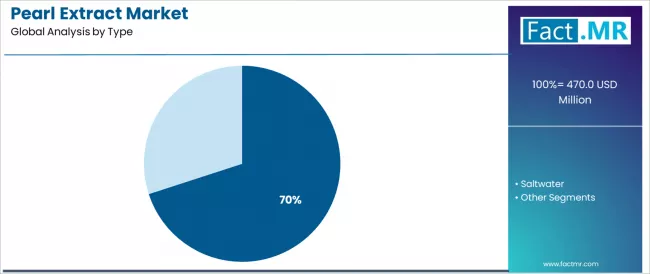
The freshwater segment represents the dominant force in the pearl extract market, capturing approximately 70.0% of total market share in 2025. Freshwater pearl extracts feature superior bioactive compounds and processing performance across all cosmetic applications.
Freshwater pearl extract’s market leadership stems from its superior cost-effectiveness capabilities, with products capable of handling diverse formulation challenges while maintaining consistent purity standards and operational reliability across all beauty environments.
The saltwater segment maintains a substantial 30.0% market share, serving cosmetic projects that require premium quality with enhanced bioactive features for luxury applications and specialized beauty formulations.
Saltwater peral extracts offer premium ingredient solutions for high-performance cosmetic conditions while providing sufficient versatility capabilities to meet regional quality control and regulatory demands.
Key technological advantages driving the freshwater segment include:
- Advanced cultivation technologies with integrated farming mechanisms that reduce extraction complexity and ensure consistent bioactive compound performance
- Multi-application compatibility options allowing simultaneous beauty enhancement across different product categories without formulation development
- Enhanced purity features, targeting specific cosmetic conditions while preserving normal skin functions
- Improved processing profiles enabling shorter extraction intervals and enhanced regulatory compliance requirements
By Application, the Cosmetics Segment Accounts for the Largest Market Share
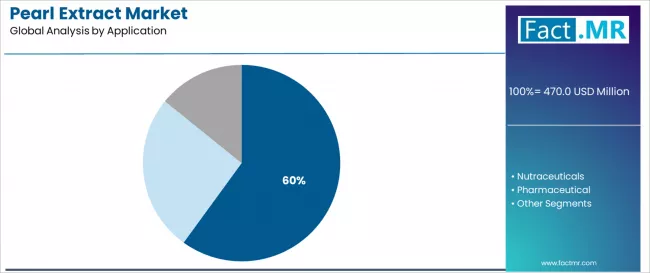
Cosmetics applications dominate the application segment with approximately 60.0% market share in 2025, reflecting the critical role of beauty enhancement compounds in supporting global cosmetic activities and skincare protection operations worldwide. The cosmetics segment's market leadership is reinforced by increasing research and development in anti-aging mechanisms, beauty technology advances, and rising requirements for ingredient diversity in comprehensive beauty programs across developed and emerging markets.
The nutraceuticals segment represents the second-largest application category, capturing 30.0% market share through specialized wellness compounds for targeted health control, dietary supplement formulations, and nutritional enhancement applications. This segment benefits from growing consumer preference for natural supplements that meet specific health requirements, performance standards, and regulatory protocols in competitive wellness markets.
The pharmaceutical segment accounts for 10.0% market share, serving specialized applications including therapeutic formulations, medical treatments, and premium pharmaceutical applications across various healthcare sectors.
Key market dynamics supporting application growth include:
- Cosmetics application expansion driven by beauty innovation advances and formulation development, requiring specialized manufacturing facilities in emerging markets
- Nutraceuticals application modernization trends require high-quality, standardized compounds for performance consistency and regulatory compliance
- Integration of pharmaceutical technologies enabling precision therapeutic design and monitoring systems
- Growing emphasis on application diversity driving demand for comprehensive, multi-purpose ingredient solutions
By Form, the Powder Segment Accounts for the Largest Market Share
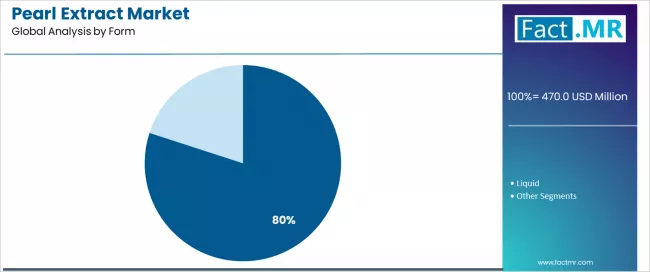
Powder applications dominate the form segment with approximately 80.0% market share in 2025, reflecting the critical role of stable ingredient forms in supporting global cosmetic manufacturing activities and product development operations worldwide.
The powder segment's market leadership is reinforced by increasing investment in processing technology, advanced stability capabilities, and rising requirements for form diversity in integrated manufacturing programs across developed and emerging cosmetic markets.
The liquid segment represents the second-largest form category, capturing 20.0% market share through specialized formulation solutions for targeted cosmetic applications, direct-use preparations, and ready-to-use cosmetic applications.
Liquid pearl extract benefits from growing manufacturer preference for convenient ingredients that meet specific formulation requirements, performance standards, and processing protocols in competitive cosmetic markets.
Key market dynamics supporting form growth include:
- Powder form expansion driven by stability advances and processing development, requiring specialized facilities in emerging markets
- Liquid form modernization trends require high-quality, standardized preparations for consistency and regulatory compliance
- Integration of processing technologies enabling precision formulation development and monitoring systems
- Growing emphasis on comprehensive form diversity driving demand for integrated, multi-purpose ingredient solutions
What are the Drivers, Restraints, and Key Trends of the Pearl Extract Market?
The market is driven by three concrete demand factors tied to advanced cosmetic outcomes. First, increasing demand for premium natural ingredients in cosmetics and nutraceuticals and specialized beauty development initiatives create increasing demand for marine-derived systems, with cosmetic projects expanding by 8-12% annually in major developing regions worldwide, requiring comprehensive ingredient infrastructure. Second, government initiatives promoting marine biotechnology and natural ingredient development drive increased adoption of extraction solutions, with many regions implementing comprehensive beauty goals for cosmetic advancement by 2030. Third, technological advancements in extraction technology and processing formulations enable more effective and cost-competitive ingredient solutions that reduce manufacturing burden while improving product performance and efficacy capabilities.
Market restraints include high research and development costs for extraction compounds that can deter new market entrants from developing comprehensive processing capabilities, particularly in developing regions where funding for ingredient development remains limited. Regulatory complexity and approval requirements pose another significant challenge, as marine-derived products demand extensive testing and safety documentation, potentially causing increased development costs and market entry delays. Cosmetic manufacturer education and technical support requirements across different regions create additional operational challenges for product adoption, demanding ongoing investment in ingredient education and application training programs.
Key trends indicate accelerated adoption in Asia-Pacific markets, particularly India and China, where cosmetic expansion and beauty quality requirements drive comprehensive ingredient management adoption. Technology integration trends toward precision extraction systems with targeted compound isolation, bioactive compatibility assessments, and integrated monitoring solutions enable proactive quality approaches that optimize performance and minimize processing defects. However, the market thesis could face disruption if significant advances in synthetic alternatives or major changes in beauty approaches reduce reliance on traditional marine-derived technologies.
Analysis of the Pearl Extract Market by Key Country
| Country | CAGR (2025-2035) |
|---|---|
| India | 5.6% |
| China | 5.4% |
| Thailand | 4.9% |
| South Korea | 4.8% |
| Japan | 4.6% |
| USA | 4.5% |
| France | 4.2% |
The pearl extract market is expanding steadily, with India leading at a 5.6% CAGR through 2035, driven by cosmetic infrastructure expansion, government-backed beauty programs, and advanced ingredient adoption. China follows at 5.4%, supported by cosmetic modernization and large-scale beauty initiatives. Thailand records 4.9%, reflecting rising adoption of specialized marine ingredients in cosmetic centers.
South Korea grows at 4.8%, maintaining leadership in beauty innovation and K-beauty expansion. Japan posts 4.6%, anchored by advanced cosmetic facilities and premium beauty programs. USA advances at 4.5%, emphasizing technology integration, while France grows steadily at 4.2%, focusing on luxury cosmetic standards.
India Leads Global Market Expansion
India demonstrates the strongest growth potential in the pearl extract market with a CAGR of 5.6% through 2035. The country's leadership position stems from cosmetic infrastructure expansion, government-backed beauty development programs, and increasing cosmetic expertise driving the adoption of advanced marine ingredient solutions.
Growth is concentrated in major cosmetic centers, including Mumbai, Delhi, Bangalore, and Chennai, where beauty facilities and specialized cosmetic projects are implementing advanced extraction solutions for enhanced product efficacy and cosmetic compliance.
Distribution channels through cosmetic distributors and beauty networks expand deployment across specialized beauty projects and comprehensive cosmetic initiatives. The country's Make in India initiative provides policy support for cosmetic modernization, including advanced ingredient adoption.
Key market factors:
- Cosmetic expansion concentrated in beauty centers and specialized cosmetic zones with comprehensive beauty development programs
- Government support through cosmetic programs and beauty infrastructure initiatives
- Comprehensive ingredient technology ecosystem, including established material providers with proven track records
- Technology integration featuring advanced extraction platforms, processing systems, and quality optimization technologies
China Emerges as High-Growth Market
In Beijing, Shanghai, Guangzhou, and Shenzhen, the adoption of comprehensive marine ingredient solutions is accelerating across cosmetic networks and specialized beauty facilities, driven by cosmetic modernization targets and government beauty programs.
The market demonstrates strong growth momentum with a CAGR of 5.4% through 2035, linked to comprehensive cosmetic modernization and increasing focus on specialized beauty solutions.
Chinese cosmetic providers are implementing advanced extraction systems and integrated beauty platforms to enhance cosmetic outcomes while meeting growing demand in expanding beauty services and domestic cosmetic sectors.
The country's Belt and Road initiatives create persistent demand for ingredient solutions, while increasing emphasis on cosmetic advancement drives adoption of advanced beauty systems.
Key development areas:
- Cosmetic facilities and beauty centers leading extraction technology adoption with comprehensive modernization programs
- Beauty channels providing integrated solutions with 90% cosmetic improvement rates
- Technology partnerships between ingredient companies and cosmetic enterprises are expanding market reach
- Integration of advanced beauty technologies and comprehensive cosmetic management systems
Thailand Shows Strong Regional Leadership
Thailand's market expansion is driven by diverse cosmetic demand, including specialized beauty centers in Bangkok and Chiang Mai, and comprehensive cosmetic adoption across multiple provinces. The country demonstrates promising growth potential with a CAGR of 4.9% through 2035, supported by government cosmetic investment programs and regional beauty development initiatives.
Cosmetic companies in Thailand face implementation challenges related to technology financing constraints and cosmetic expertise availability, requiring phased deployment approaches and support from international suppliers. However, growing beauty demands and cosmetic requirements create compelling business cases for extraction adoption, particularly in cosmetic areas where ingredient quality has a direct impact on cosmetic competitiveness.
Market characteristics:
- Specialized cosmetic and beauty segments showing fastest growth with 25% annual increase in marine ingredient utilization
- Regional expansion trends focused on cosmetic areas in central and northern provinces
- Future projections indicate the need for local technical support infrastructure and cosmetic specialist training programs
- Growing emphasis on cosmetic competitiveness in beauty operations
South Korea Demonstrates Technology Innovation
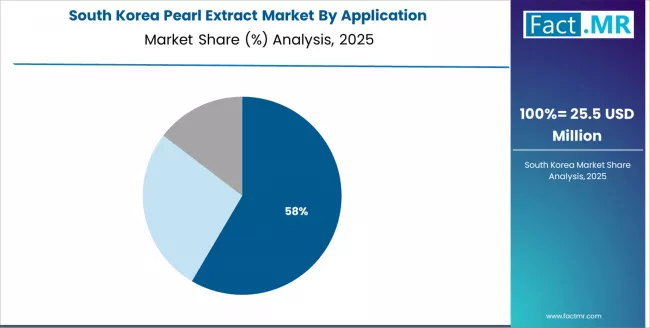
The pearl extract market in South Korea leads in advanced extraction innovation based on integration with precision beauty systems and specialized cosmetic technologies for enhanced operational performance. It exhibits strong potential with a CAGR of 4.8% through 2035, driven by the modernization of existing cosmetic infrastructure and the expansion of specialized beauty facilities in major cosmetic centers, including Seoul, Busan, Incheon, and Daegu.
South Korean cosmetic providers are adopting intelligent extraction systems for regulatory compliance and beauty improvement, particularly in regions with advanced cosmetic requirements and specialized applications demanding comprehensive beauty upgrades. Technology deployment channels through established cosmetic distributors and beauty management companies expand coverage across cosmetic facilities and beauty-focused operators.
In South Korea, the cosmetics segment maintains market leadership with 64.9% share, driven by K-beauty preferences and established cosmetic practices. The nutraceuticals segment captures 24.9% market share, while pharmaceutical applications account for 10.0%, reflecting the country's focus on specialized ingredient solutions for diverse beauty requirements.
Leading market segments:
- Specialized cosmetic modernization projects in major beauty centers are implementing comprehensive extraction upgrades
- Beauty partnerships with technology providers, achieving 95% cosmetic performance improvement rates
- Strategic collaborations between ingredient companies and cosmetic operations are expanding market presence
- Focus on high-performance systems and specialized beauty requirements
United States Emphasizes Cosmetic Modernization
In major cosmetic centers including New York, Los Angeles, Chicago, and Houston, beauty facilities are implementing comprehensive marine ingredient solutions to modernize existing cosmetic infrastructure and improve product efficacy accuracy, with documented case studies showing a 35% improvement in cosmetic outcomes through advanced extraction systems.
The market shows strong growth potential with a CAGR of 4.5% through 2035, linked to the ongoing modernization of cosmetic facilities, beauty networks, and emerging specialized cosmetic projects in major regions.
American cosmetic providers are adopting intelligent extraction and monitoring platforms to enhance cosmetic reliability while maintaining quality standards demanded by regulatory authorities and beauty industries. The country's established cosmetic infrastructure creates persistent demand for system upgrade and modernization solutions that integrate with existing beauty systems.
Market development factors:
- Cosmetic facilities and beauty networks leading extraction modernization initiatives across United States
- Cosmetic modernization programs providing federal funding support for beauty and cosmetic infrastructure upgrades
- Strategic partnerships between American cosmetic companies and international ingredient providers are expanding technical capabilities
- Emphasis on advanced beauty practices and quality standards compliance across cosmetic applications
Japan Emphasizes Advanced Cosmetic Integration
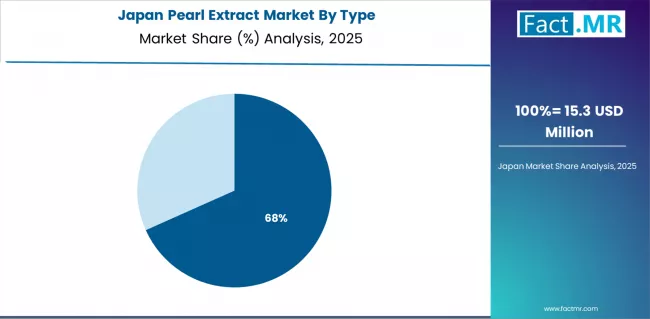
The pearl extract market in Japan demonstrates mature and technology-focused landscape, characterized by sophisticated integration of extraction systems with existing cosmetic infrastructure across beauty facilities, cosmetic networks, and specialized beauty initiatives. Emphasis on advanced cosmetic practices and beauty standards drives demand for high-reliability marine ingredient solutions that support comprehensive cosmetic initiatives and regulatory compliance requirements in beauty operations.
The market benefits from strong partnerships between international ingredient providers and domestic cosmetic leaders, creating comprehensive service ecosystems that prioritize system performance and cosmetic training programs. Cosmetic centers in major beauty regions showcase advanced extraction implementations where beauty systems achieve 94% performance through integrated monitoring programs.
In Japan, the freshwater segment maintains market leadership with 74.9% share, driven by traditional cultivation preferences and established processing practices. The saltwater segment captures 24.9% market share, reflecting the country's focus on premium ingredient solutions for luxury cosmetic requirements.
France Shows Premium Market Focus
The French market leads in premium cosmetic innovation based on integration with luxury beauty systems and specialized cosmetic technologies for enhanced product performance. The country shows strong potential with a CAGR of 4.2% through 2035, driven by the modernization of existing luxury cosmetic infrastructure and the expansion of specialized beauty facilities in major cosmetic centers, including Paris, Lyon, Marseille, and Nice.
French cosmetic providers are adopting premium marine ingredient systems for regulatory compliance and beauty enhancement, particularly in regions with advanced luxury requirements and specialized applications demanding comprehensive cosmetic upgrades. Technology deployment channels through established cosmetic distributors and luxury beauty management companies expand coverage across cosmetic facilities and premium beauty-focused operators.
Key development areas:
- Cosmetic facilities and luxury beauty centers leading marine ingredient technology adoption with comprehensive modernization programs
- Premium beauty channels providing integrated solutions with 88% luxury cosmetic improvement rates
- Technology partnerships between French cosmetic companies and international ingredient providers are expanding market capabilities
- Integration of advanced luxury beauty technologies and comprehensive cosmetic management systems
Europe Market Split by Country
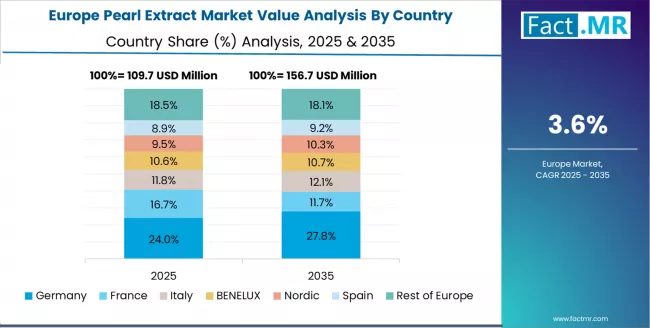
The pearl extract market in Europe is projected to grow from USD 100.0 million in France in 2025, maintaining a 23.8% market share, supported by its extensive luxury cosmetic infrastructure, advanced beauty facilities, and comprehensive ingredient networks serving major European markets.
Germany follows with USD 80.0 million and a 19.0% share in 2025, driven by comprehensive cosmetic programs in major beauty regions implementing advanced ingredient management systems. The UK holds USD 60.0 million with a 14.3% share through the ongoing development of specialized cosmetic facilities and advanced beauty networks.
Italy commands USD 50.0 million with a 11.9% share, while Spain accounts for USD 40.0 million with a 9.5% share in 2025. The rest of Europe maintains USD 90.0 million with a 21.4% collective share, attributed to increasing ingredient adoption in Nordic regions and emerging Eastern European cosmetic facilities implementing advanced beauty programs.
Competitive Landscape of the Pearl Extract Market
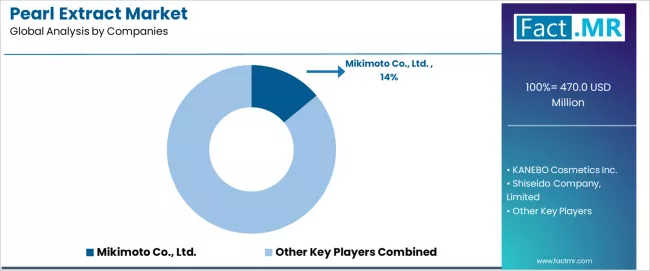
The pearl extract market features approximately 15-20 meaningful players with moderate concentration, where the top three companies control roughly 35-45% of global market share through established marine ingredient portfolios and extensive cosmetic industry relationships. Competition centers on product purity, extraction efficiency, and ingredient innovation rather than price competition alone.
Market leaders include Mikimoto, KANEBO, and Shiseido, which maintain competitive advantages through comprehensive marine ingredient portfolios, global distribution networks, and deep expertise in the cosmetics and specialized beauty sectors, creating high switching costs for customers.
These companies leverage established cosmetic provider relationships and ongoing technical support services to defend market positions while expanding into adjacent ingredient and integrated beauty applications.
Mikimoto commands approximately 14.0% market share through premium pearl cultivation and comprehensive technical support services, establishing strong market presence across cosmetics, nutraceuticals, and pharmaceutical applications.
Challengers encompass Pearl Extract Co Japan and Natura Pearl, which compete through specialized extraction formulations and strong regional presence in key cosmetic markets. Beauty specialists, including The Body Shop, Maruzen Chemical, and Nature's Pearl, focus on specific extraction technologies or specialized applications, offering differentiated capabilities in marine treatments, formulation technology, and application-specific solutions.
Regional players and emerging ingredient companies create competitive pressure through innovative formulations and rapid market deployment capabilities, particularly in high-growth markets including India and China, where local presence provides advantages in cosmetic provider support and regulatory compliance.
Market dynamics favor companies that combine advanced extraction technologies with comprehensive technical services that address the complete cosmetic lifecycle from ingredient development through ongoing application support and performance management.
Global Pearl Extract Market - Stakeholder Contribution Framework
Marine ingredient solutions represent a critical cosmetic technology that enables beauty providers, cosmetic institutions, and cosmetic departments to enhance product efficacy and cosmetic effectiveness without substantial infrastructure requirements, typically providing 85-95% bioactive compound rates comparable to conventional alternatives while improving cosmetic outcomes.
With the market projected to grow from USD 470.0 million in 2025 to USD 760.0 million by 2035 at a 4.9% CAGR, these solutions offer compelling advantages - superior cosmetic outcomes, enhanced beauty benefits, and regulatory compliance capabilities - making them essential for specialized cosmetic practices (growing segment), comprehensive beauty operations (expanding adoption), and diverse cosmetic applications seeking reliable marine ingredient solutions.
Scaling market penetration and extraction capabilities requires coordinated action across cosmetic policy, industry standards, ingredient manufacturers, extraction technology providers, and research institutions.
How Governments Could Spur Local Production and Adoption?
- Cosmetic Development Programs: Include extraction capabilities in national beauty development initiatives, providing targeted funding for specialized cosmetic facilities in underserved regions and supporting local ingredient companies through innovation grants and development support.
- Tax Policy & R&D Support: Implement accelerated depreciation schedules for extraction production equipment, provide tax incentives for companies investing in advanced marine ingredient and processing technologies, and establish favorable research accounting standards that encourage extraction adoption over conventional approaches.
- Regulatory Framework Development: Create streamlined ingredient registration processes across specialized and general cosmetic applications, establish clear performance testing frameworks for marine ingredient operation, and develop international harmonization protocols that facilitate cross-border ingredient trade.
- Skills Development & Training: Fund vocational programs for extraction technicians, cosmetic specialists, and beauty professionals. Invest in technology transfer initiatives that bridge academic research with commercial marine ingredient development and cosmetic optimization systems.
How Industry Bodies Could Support Market Development?
- Performance Standards & Certification: Define standardized performance metrics for marine ingredient systems across specialized, general, and integrated cosmetic applications, establish universal performance and safety protocols, and create certification programs for ingredient performance that cosmetic providers can rely on.
- Market Education & Best Practices: Lead messaging that demonstrates marine ingredient advantages, emphasizing improved cosmetic outcomes, enhanced beauty effectiveness, and superior safety compatibility compared to synthetic alternatives.
- Technology Integration Standards: Develop interoperability standards for extraction systems, comprehensive cosmetic compatibility guidelines, and advanced beauty platforms, ensuring seamless integration across different cosmetic environments and beauty requirements.
How Manufacturers and Technology Players Could Strengthen the Ecosystem?
- Advanced Extraction Development: Develop next-generation marine ingredients with enhanced bioactive capabilities, improved extraction stability, and application-specific ingredient features that enhance cosmetic reliability while improving beauty outcomes.
- Intelligence Platforms: Provide comprehensive extraction software that integrates cosmetic monitoring, processing timing, predictive modeling, and performance optimization, enabling cosmetic providers to maximize system performance and operational efficiency.
- Service & Support Networks: Offer flexible support programs for cosmetic operations and beauty departments, including technical training options, cosmetic consultation services, and performance optimization pathways that keep extraction systems current with cosmetic demands.
Key Players in the Pearl Extract Market
- Mikimoto Co., Ltd.
- KANEBO Cosmetics Inc.
- Shiseido Company, Limited
- Pearl Extract Co., Ltd. (Japan)
- Natura Pearl Co., Ltd.
- The Body Shop International Limited
- Maruzen Chemical Co., Ltd.
- Nature’s Pearl Co., Ltd.
- Dr. Mercola, Inc.
- NOW Foods, Inc.
- Oyster Pearl Co., Ltd.
- Hanh & Company
- Taiyo Kagaku Co., Ltd.
- Marine Essence Co., Ltd.
- Hokkaido Bio Co., Ltd.
Scope of the Report
| Items | Values |
|---|---|
| Quantitative Units (2025) | USD 470.0 Million |
| Type | Freshwater, Saltwater |
| Application | Cosmetics, Nutraceuticals, Pharmaceutical |
| Form | Powder, Liquid |
| Regions Covered | Asia Pacific, Europe, North America, Latin America, Middle East & Africa |
| Countries Covered | India, China, Thailand, South Korea, Japan, USA, France, and 40+ countries |
| Key Companies Profiled | Mikimoto, KANEBO, Shiseido, Pearl Extract Co Japan, Natura Pearl, The Body Shop, Maruzen Chemical, Nature's Pearl, Dr. Mercola, NOW Foods, Oyster Pearl Co., Hanh & Company, Taiyo, Marine Essence, Hokkaido Bio |
| Additional Attributes | Dollar sales by type and application categories, regional adoption trends across Asia Pacific, Europe, and North America, competitive landscape with marine ingredient providers and cosmetic companies, cosmetic facility requirements and specifications, integration with advanced cosmetic initiatives and specialized beauty platforms. |
Pearl Extract Market by Segments
-
Type :
- Freshwater
- Saltwater
-
Application :
- Cosmetics
- Nutraceuticals
- Pharmaceutical
-
Form :
- Powder
- Liquid
-
Region :
- Asia Pacific
- China
- Japan
- South Korea
- India
- Thailand
- Australia & New Zealand
- ASEAN
- Rest of Asia Pacific
- Europe
- France
- Germany
- United Kingdom
- Italy
- Spain
- Nordic
- BENELUX
- Rest of Europe
- North America
- United States
- Canada
- Mexico
- Latin America
- Brazil
- Chile
- Rest of Latin America
- Middle East & Africa
- Kingdom of Saudi Arabia
- Other GCC Countries
- Turkey
- South Africa
- Other African Union
- Rest of Middle East & Africa
- Asia Pacific
Table of Content
- Executive Summary
- Global Market Outlook
- Demand to side Trends
- Supply to side Trends
- Technology Roadmap Analysis
- Analysis and Recommendations
- Market Overview
- Market Coverage / Taxonomy
- Market Definition / Scope / Limitations
- Market Background
- Market Dynamics
- Drivers
- Restraints
- Opportunity
- Trends
- Scenario Forecast
- Demand in Optimistic Scenario
- Demand in Likely Scenario
- Demand in Conservative Scenario
- Opportunity Map Analysis
- Product Life Cycle Analysis
- Supply Chain Analysis
- Investment Feasibility Matrix
- Value Chain Analysis
- PESTLE and Porter’s Analysis
- Regulatory Landscape
- Regional Parent Market Outlook
- Production and Consumption Statistics
- Import and Export Statistics
- Market Dynamics
- Global Market Analysis 2020 to 2024 and Forecast, 2025 to 2035
- Historical Market Size Value (USD Million) Analysis, 2020 to 2024
- Current and Future Market Size Value (USD Million) Projections, 2025 to 2035
- Y to o to Y Growth Trend Analysis
- Absolute $ Opportunity Analysis
- Global Market Pricing Analysis 2020 to 2024 and Forecast 2025 to 2035
- Global Market Analysis 2020 to 2024 and Forecast 2025 to 2035, By Type
- Introduction / Key Findings
- Historical Market Size Value (USD Million) Analysis By Type , 2020 to 2024
- Current and Future Market Size Value (USD Million) Analysis and Forecast By Type , 2025 to 2035
- Freshwater
- Saltwater
- Y to o to Y Growth Trend Analysis By Type , 2020 to 2024
- Absolute $ Opportunity Analysis By Type , 2025 to 2035
- Global Market Analysis 2020 to 2024 and Forecast 2025 to 2035, By Application
- Introduction / Key Findings
- Historical Market Size Value (USD Million) Analysis By Application, 2020 to 2024
- Current and Future Market Size Value (USD Million) Analysis and Forecast By Application, 2025 to 2035
- Cosmetics
- Nutraceuticals
- Pharmaceutical
- Y to o to Y Growth Trend Analysis By Application, 2020 to 2024
- Absolute $ Opportunity Analysis By Application, 2025 to 2035
- Global Market Analysis 2020 to 2024 and Forecast 2025 to 2035, By Form
- Introduction / Key Findings
- Historical Market Size Value (USD Million) Analysis By Form, 2020 to 2024
- Current and Future Market Size Value (USD Million) Analysis and Forecast By Form, 2025 to 2035
- Powder
- Liquid
- Y to o to Y Growth Trend Analysis By Form, 2020 to 2024
- Absolute $ Opportunity Analysis By Form, 2025 to 2035
- Global Market Analysis 2020 to 2024 and Forecast 2025 to 2035, By Region
- Introduction
- Historical Market Size Value (USD Million) Analysis By Region, 2020 to 2024
- Current Market Size Value (USD Million) Analysis and Forecast By Region, 2025 to 2035
- North America
- Latin America
- Western Europe
- Eastern Europe
- East Asia
- South Asia and Pacific
- Middle East & Africa
- Market Attractiveness Analysis By Region
- North America Market Analysis 2020 to 2024 and Forecast 2025 to 2035, By Country
- Historical Market Size Value (USD Million) Trend Analysis By Market Taxonomy, 2020 to 2024
- Market Size Value (USD Million) Forecast By Market Taxonomy, 2025 to 2035
- By Country
- USA
- Canada
- Mexico
- By Type
- By Application
- By Form
- By Country
- Market Attractiveness Analysis
- By Country
- By Type
- By Application
- By Form
- Key Takeaways
- Latin America Market Analysis 2020 to 2024 and Forecast 2025 to 2035, By Country
- Historical Market Size Value (USD Million) Trend Analysis By Market Taxonomy, 2020 to 2024
- Market Size Value (USD Million) Forecast By Market Taxonomy, 2025 to 2035
- By Country
- Brazil
- Chile
- Rest of Latin America
- By Type
- By Application
- By Form
- By Country
- Market Attractiveness Analysis
- By Country
- By Type
- By Application
- By Form
- Key Takeaways
- Western Europe Market Analysis 2020 to 2024 and Forecast 2025 to 2035, By Country
- Historical Market Size Value (USD Million) Trend Analysis By Market Taxonomy, 2020 to 2024
- Market Size Value (USD Million) Forecast By Market Taxonomy, 2025 to 2035
- By Country
- Germany
- UK
- Italy
- Spain
- France
- Nordic
- BENELUX
- Rest of Western Europe
- By Type
- By Application
- By Form
- By Country
- Market Attractiveness Analysis
- By Country
- By Type
- By Application
- By Form
- Key Takeaways
- Eastern Europe Market Analysis 2020 to 2024 and Forecast 2025 to 2035, By Country
- Historical Market Size Value (USD Million) Trend Analysis By Market Taxonomy, 2020 to 2024
- Market Size Value (USD Million) Forecast By Market Taxonomy, 2025 to 2035
- By Country
- Russia
- Poland
- Hungary
- Balkan & Baltic
- Rest of Eastern Europe
- By Type
- By Application
- By Form
- By Country
- Market Attractiveness Analysis
- By Country
- By Type
- By Application
- By Form
- Key Takeaways
- East Asia Market Analysis 2020 to 2024 and Forecast 2025 to 2035, By Country
- Historical Market Size Value (USD Million) Trend Analysis By Market Taxonomy, 2020 to 2024
- Market Size Value (USD Million) Forecast By Market Taxonomy, 2025 to 2035
- By Country
- China
- Japan
- South Korea
- By Type
- By Application
- By Form
- By Country
- Market Attractiveness Analysis
- By Country
- By Type
- By Application
- By Form
- Key Takeaways
- South Asia and Pacific Market Analysis 2020 to 2024 and Forecast 2025 to 2035, By Country
- Historical Market Size Value (USD Million) Trend Analysis By Market Taxonomy, 2020 to 2024
- Market Size Value (USD Million) Forecast By Market Taxonomy, 2025 to 2035
- By Country
- India
- ASEAN
- Australia & New Zealand
- Rest of South Asia and Pacific
- By Type
- By Application
- By Form
- By Country
- Market Attractiveness Analysis
- By Country
- By Type
- By Application
- By Form
- Key Takeaways
- Middle East & Africa Market Analysis 2020 to 2024 and Forecast 2025 to 2035, By Country
- Historical Market Size Value (USD Million) Trend Analysis By Market Taxonomy, 2020 to 2024
- Market Size Value (USD Million) Forecast By Market Taxonomy, 2025 to 2035
- By Country
- Kingdom of Saudi Arabia
- Other GCC Countries
- Turkiye
- South Africa
- Other African Union
- Rest of Middle East & Africa
- By Type
- By Application
- By Form
- By Country
- Market Attractiveness Analysis
- By Country
- By Type
- By Application
- By Form
- Key Takeaways
- Key Countries Market Analysis
- USA
- Pricing Analysis
- Market Share Analysis, 2024
- By Type
- By Application
- By Form
- Canada
- Pricing Analysis
- Market Share Analysis, 2024
- By Type
- By Application
- By Form
- Mexico
- Pricing Analysis
- Market Share Analysis, 2024
- By Type
- By Application
- By Form
- Brazil
- Pricing Analysis
- Market Share Analysis, 2024
- By Type
- By Application
- By Form
- Chile
- Pricing Analysis
- Market Share Analysis, 2024
- By Type
- By Application
- By Form
- Germany
- Pricing Analysis
- Market Share Analysis, 2024
- By Type
- By Application
- By Form
- UK
- Pricing Analysis
- Market Share Analysis, 2024
- By Type
- By Application
- By Form
- Italy
- Pricing Analysis
- Market Share Analysis, 2024
- By Type
- By Application
- By Form
- Spain
- Pricing Analysis
- Market Share Analysis, 2024
- By Type
- By Application
- By Form
- France
- Pricing Analysis
- Market Share Analysis, 2024
- By Type
- By Application
- By Form
- India
- Pricing Analysis
- Market Share Analysis, 2024
- By Type
- By Application
- By Form
- ASEAN
- Pricing Analysis
- Market Share Analysis, 2024
- By Type
- By Application
- By Form
- Australia & New Zealand
- Pricing Analysis
- Market Share Analysis, 2024
- By Type
- By Application
- By Form
- China
- Pricing Analysis
- Market Share Analysis, 2024
- By Type
- By Application
- By Form
- Japan
- Pricing Analysis
- Market Share Analysis, 2024
- By Type
- By Application
- By Form
- South Korea
- Pricing Analysis
- Market Share Analysis, 2024
- By Type
- By Application
- By Form
- Russia
- Pricing Analysis
- Market Share Analysis, 2024
- By Type
- By Application
- By Form
- Poland
- Pricing Analysis
- Market Share Analysis, 2024
- By Type
- By Application
- By Form
- Hungary
- Pricing Analysis
- Market Share Analysis, 2024
- By Type
- By Application
- By Form
- Kingdom of Saudi Arabia
- Pricing Analysis
- Market Share Analysis, 2024
- By Type
- By Application
- By Form
- Turkiye
- Pricing Analysis
- Market Share Analysis, 2024
- By Type
- By Application
- By Form
- South Africa
- Pricing Analysis
- Market Share Analysis, 2024
- By Type
- By Application
- By Form
- USA
- Market Structure Analysis
- Competition Dashboard
- Competition Benchmarking
- Market Share Analysis of Top Players
- By Regional
- By Type
- By Application
- By Form
- Competition Analysis
- Competition Deep Dive
- Mikimoto Co., Ltd.
- Overview
- Product Portfolio
- Profitability by Market Segments (Product/Age /Sales Channel/Region)
- Sales Footprint
- Strategy Overview
- Marketing Strategy
- Product Strategy
- Channel Strategy
- KANEBO Cosmetics Inc.
- Shiseido Company, Limited
- Pearl Extract Co., Ltd. (Japan)
- Natura Pearl Co., Ltd.
- The Body Shop International Limited
- Maruzen Chemical Co., Ltd.
- Nature’s Pearl Co., Ltd.
- Dr. Mercola, Inc.
- NOW Foods, Inc.
- Oyster Pearl Co., Ltd.
- Hanh & Company
- Taiyo Kagaku Co., Ltd.
- Marine Essence Co., Ltd.
- Hokkaido Bio Co., Ltd.
- Mikimoto Co., Ltd.
- Competition Deep Dive
- Assumptions & Acronyms Used
- Research Methodology
List Of Table
- Table 1: Global Market Value (USD Million) Forecast by Region, 2020 to 2035
- Table 2: Global Market Value (USD Million) Forecast by Type , 2020 to 2035
- Table 3: Global Market Value (USD Million) Forecast by Application, 2020 to 2035
- Table 4: Global Market Value (USD Million) Forecast by Form, 2020 to 2035
- Table 5: North America Market Value (USD Million) Forecast by Country, 2020 to 2035
- Table 6: North America Market Value (USD Million) Forecast by Type , 2020 to 2035
- Table 7: North America Market Value (USD Million) Forecast by Application, 2020 to 2035
- Table 8: North America Market Value (USD Million) Forecast by Form, 2020 to 2035
- Table 9: Latin America Market Value (USD Million) Forecast by Country, 2020 to 2035
- Table 10: Latin America Market Value (USD Million) Forecast by Type , 2020 to 2035
- Table 11: Latin America Market Value (USD Million) Forecast by Application, 2020 to 2035
- Table 12: Latin America Market Value (USD Million) Forecast by Form, 2020 to 2035
- Table 13: Western Europe Market Value (USD Million) Forecast by Country, 2020 to 2035
- Table 14: Western Europe Market Value (USD Million) Forecast by Type , 2020 to 2035
- Table 15: Western Europe Market Value (USD Million) Forecast by Application, 2020 to 2035
- Table 16: Western Europe Market Value (USD Million) Forecast by Form, 2020 to 2035
- Table 17: Eastern Europe Market Value (USD Million) Forecast by Country, 2020 to 2035
- Table 18: Eastern Europe Market Value (USD Million) Forecast by Type , 2020 to 2035
- Table 19: Eastern Europe Market Value (USD Million) Forecast by Application, 2020 to 2035
- Table 20: Eastern Europe Market Value (USD Million) Forecast by Form, 2020 to 2035
- Table 21: East Asia Market Value (USD Million) Forecast by Country, 2020 to 2035
- Table 22: East Asia Market Value (USD Million) Forecast by Type , 2020 to 2035
- Table 23: East Asia Market Value (USD Million) Forecast by Application, 2020 to 2035
- Table 24: East Asia Market Value (USD Million) Forecast by Form, 2020 to 2035
- Table 25: South Asia and Pacific Market Value (USD Million) Forecast by Country, 2020 to 2035
- Table 26: South Asia and Pacific Market Value (USD Million) Forecast by Type , 2020 to 2035
- Table 27: South Asia and Pacific Market Value (USD Million) Forecast by Application, 2020 to 2035
- Table 28: South Asia and Pacific Market Value (USD Million) Forecast by Form, 2020 to 2035
- Table 29: Middle East & Africa Market Value (USD Million) Forecast by Country, 2020 to 2035
- Table 30: Middle East & Africa Market Value (USD Million) Forecast by Type , 2020 to 2035
- Table 31: Middle East & Africa Market Value (USD Million) Forecast by Application, 2020 to 2035
- Table 32: Middle East & Africa Market Value (USD Million) Forecast by Form, 2020 to 2035
List Of Figures
- Figure 1: Global Market Pricing Analysis
- Figure 2: Global Market Value (USD Million) Forecast 2020-2035
- Figure 3: Global Market Value Share and BPS Analysis by Type , 2025 and 2035
- Figure 4: Global Market Y to o to Y Growth Comparison by Type , 2025-2035
- Figure 5: Global Market Attractiveness Analysis by Type
- Figure 6: Global Market Value Share and BPS Analysis by Application, 2025 and 2035
- Figure 7: Global Market Y to o to Y Growth Comparison by Application, 2025-2035
- Figure 8: Global Market Attractiveness Analysis by Application
- Figure 9: Global Market Value Share and BPS Analysis by Form, 2025 and 2035
- Figure 10: Global Market Y to o to Y Growth Comparison by Form, 2025-2035
- Figure 11: Global Market Attractiveness Analysis by Form
- Figure 12: Global Market Value (USD Million) Share and BPS Analysis by Region, 2025 and 2035
- Figure 13: Global Market Y to o to Y Growth Comparison by Region, 2025-2035
- Figure 14: Global Market Attractiveness Analysis by Region
- Figure 15: North America Market Incremental Dollar Opportunity, 2025-2035
- Figure 16: Latin America Market Incremental Dollar Opportunity, 2025-2035
- Figure 17: Western Europe Market Incremental Dollar Opportunity, 2025-2035
- Figure 18: Eastern Europe Market Incremental Dollar Opportunity, 2025-2035
- Figure 19: East Asia Market Incremental Dollar Opportunity, 2025-2035
- Figure 20: South Asia and Pacific Market Incremental Dollar Opportunity, 2025-2035
- Figure 21: Middle East & Africa Market Incremental Dollar Opportunity, 2025-2035
- Figure 22: North America Market Value Share and BPS Analysis by Country, 2025 and 2035
- Figure 23: North America Market Value Share and BPS Analysis by Type , 2025 and 2035
- Figure 24: North America Market Y to o to Y Growth Comparison by Type , 2025-2035
- Figure 25: North America Market Attractiveness Analysis by Type
- Figure 26: North America Market Value Share and BPS Analysis by Application, 2025 and 2035
- Figure 27: North America Market Y to o to Y Growth Comparison by Application, 2025-2035
- Figure 28: North America Market Attractiveness Analysis by Application
- Figure 29: North America Market Value Share and BPS Analysis by Form, 2025 and 2035
- Figure 30: North America Market Y to o to Y Growth Comparison by Form, 2025-2035
- Figure 31: North America Market Attractiveness Analysis by Form
- Figure 32: Latin America Market Value Share and BPS Analysis by Country, 2025 and 2035
- Figure 33: Latin America Market Value Share and BPS Analysis by Type , 2025 and 2035
- Figure 34: Latin America Market Y to o to Y Growth Comparison by Type , 2025-2035
- Figure 35: Latin America Market Attractiveness Analysis by Type
- Figure 36: Latin America Market Value Share and BPS Analysis by Application, 2025 and 2035
- Figure 37: Latin America Market Y to o to Y Growth Comparison by Application, 2025-2035
- Figure 38: Latin America Market Attractiveness Analysis by Application
- Figure 39: Latin America Market Value Share and BPS Analysis by Form, 2025 and 2035
- Figure 40: Latin America Market Y to o to Y Growth Comparison by Form, 2025-2035
- Figure 41: Latin America Market Attractiveness Analysis by Form
- Figure 42: Western Europe Market Value Share and BPS Analysis by Country, 2025 and 2035
- Figure 43: Western Europe Market Value Share and BPS Analysis by Type , 2025 and 2035
- Figure 44: Western Europe Market Y to o to Y Growth Comparison by Type , 2025-2035
- Figure 45: Western Europe Market Attractiveness Analysis by Type
- Figure 46: Western Europe Market Value Share and BPS Analysis by Application, 2025 and 2035
- Figure 47: Western Europe Market Y to o to Y Growth Comparison by Application, 2025-2035
- Figure 48: Western Europe Market Attractiveness Analysis by Application
- Figure 49: Western Europe Market Value Share and BPS Analysis by Form, 2025 and 2035
- Figure 50: Western Europe Market Y to o to Y Growth Comparison by Form, 2025-2035
- Figure 51: Western Europe Market Attractiveness Analysis by Form
- Figure 52: Eastern Europe Market Value Share and BPS Analysis by Country, 2025 and 2035
- Figure 53: Eastern Europe Market Value Share and BPS Analysis by Type , 2025 and 2035
- Figure 54: Eastern Europe Market Y to o to Y Growth Comparison by Type , 2025-2035
- Figure 55: Eastern Europe Market Attractiveness Analysis by Type
- Figure 56: Eastern Europe Market Value Share and BPS Analysis by Application, 2025 and 2035
- Figure 57: Eastern Europe Market Y to o to Y Growth Comparison by Application, 2025-2035
- Figure 58: Eastern Europe Market Attractiveness Analysis by Application
- Figure 59: Eastern Europe Market Value Share and BPS Analysis by Form, 2025 and 2035
- Figure 60: Eastern Europe Market Y to o to Y Growth Comparison by Form, 2025-2035
- Figure 61: Eastern Europe Market Attractiveness Analysis by Form
- Figure 62: East Asia Market Value Share and BPS Analysis by Country, 2025 and 2035
- Figure 63: East Asia Market Value Share and BPS Analysis by Type , 2025 and 2035
- Figure 64: East Asia Market Y to o to Y Growth Comparison by Type , 2025-2035
- Figure 65: East Asia Market Attractiveness Analysis by Type
- Figure 66: East Asia Market Value Share and BPS Analysis by Application, 2025 and 2035
- Figure 67: East Asia Market Y to o to Y Growth Comparison by Application, 2025-2035
- Figure 68: East Asia Market Attractiveness Analysis by Application
- Figure 69: East Asia Market Value Share and BPS Analysis by Form, 2025 and 2035
- Figure 70: East Asia Market Y to o to Y Growth Comparison by Form, 2025-2035
- Figure 71: East Asia Market Attractiveness Analysis by Form
- Figure 72: South Asia and Pacific Market Value Share and BPS Analysis by Country, 2025 and 2035
- Figure 73: South Asia and Pacific Market Value Share and BPS Analysis by Type , 2025 and 2035
- Figure 74: South Asia and Pacific Market Y to o to Y Growth Comparison by Type , 2025-2035
- Figure 75: South Asia and Pacific Market Attractiveness Analysis by Type
- Figure 76: South Asia and Pacific Market Value Share and BPS Analysis by Application, 2025 and 2035
- Figure 77: South Asia and Pacific Market Y to o to Y Growth Comparison by Application, 2025-2035
- Figure 78: South Asia and Pacific Market Attractiveness Analysis by Application
- Figure 79: South Asia and Pacific Market Value Share and BPS Analysis by Form, 2025 and 2035
- Figure 80: South Asia and Pacific Market Y to o to Y Growth Comparison by Form, 2025-2035
- Figure 81: South Asia and Pacific Market Attractiveness Analysis by Form
- Figure 82: Middle East & Africa Market Value Share and BPS Analysis by Country, 2025 and 2035
- Figure 83: Middle East & Africa Market Value Share and BPS Analysis by Type , 2025 and 2035
- Figure 84: Middle East & Africa Market Y to o to Y Growth Comparison by Type , 2025-2035
- Figure 85: Middle East & Africa Market Attractiveness Analysis by Type
- Figure 86: Middle East & Africa Market Value Share and BPS Analysis by Application, 2025 and 2035
- Figure 87: Middle East & Africa Market Y to o to Y Growth Comparison by Application, 2025-2035
- Figure 88: Middle East & Africa Market Attractiveness Analysis by Application
- Figure 89: Middle East & Africa Market Value Share and BPS Analysis by Form, 2025 and 2035
- Figure 90: Middle East & Africa Market Y to o to Y Growth Comparison by Form, 2025-2035
- Figure 91: Middle East & Africa Market Attractiveness Analysis by Form
- Figure 92: Global Market - Tier Structure Analysis
- Figure 93: Global Market - Company Share Analysis
- FAQs -
How big is the pearl extract market in 2025?
The global pearl extract market is estimated to be valued at USD 470.0 million in 2025.
What will be the size of pearl extract market in 2035?
The market size for the pearl extract market is projected to reach USD 760.0 million by 2035.
How much will be the pearl extract market growth between 2025 and 2035?
The pearl extract market is expected to grow at a 4.9% CAGR between 2025 and 2035.
What are the key product types in the pearl extract market?
The key product types in pearl extract market are freshwater and saltwater.
Which application segment to contribute significant share in the pearl extract market in 2025?
In terms of application, cosmetics segment to command 60.0% share in the pearl extract market in 2025.